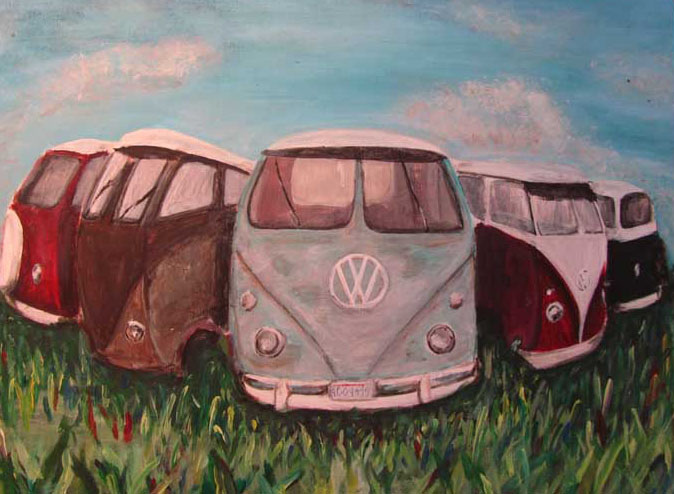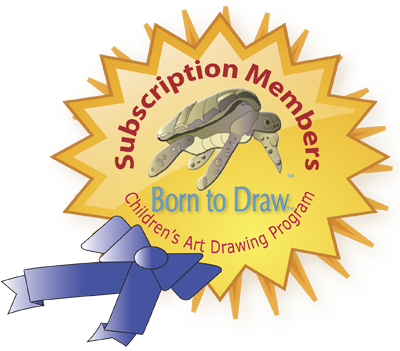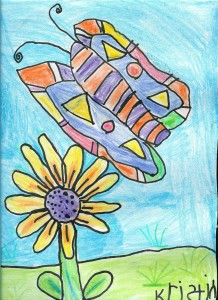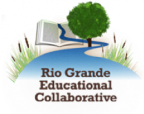Transition in Art Education: Part 3 by Ronald Neperud

A piece by Ben Schuman (Volcano Vista High, Albuquerque, NM) that was available for A is for Art auction on September 9, 2011
TOWARD A POST-POST-MODERN ART EDUCATION
There is no doubt that the postmodern critiques of art, educational gender, social class, and related issues that have employed critical analysis, semlotics, poststructuralism, and other deconstructionist approaches, have played an important role in revealing biases and power structures detrimental to equitable practices.
After our biased assumptions and practices have been deconstructed, then what?
What have critical analyses of art education contributed to the field? How can we build upon the insights that have been gained without falling back upon accepted practices? Traditional association of progress with change has been questioned, indicating that progress is not a straight linear construct. In response to the question of what follows deconstruction of long held ideas and practices, I am optimistic that as educators our practices somehow will address some of the inequities revealed by critical educational thought. There is a growing body of voices indicating that either/or antagonistic paradigms will not advance education in general or art education in particular.
Since art is so central to views of art education, whatever one’s ideological position, I think that we should consider how it might offer a direction beyond pessimism. Gablik (1991) offers two views of postmodernism, a deconstructive and a reconstructive version, representing opposing philosophical positions. Probably, most views of postmodern art are of the contradictory deconstructive type. “Reconstructivists are trying to make the transition from Eurocentric, patriarchal thinking and the ‘dominator’ model of culture toward an aesthetics of interconnectedness, social responsibility and ecological attunement” (p. 22). It seems relatively unimportant whether one labels this view as postmodern or post-postmodern. What is important is that the reconstructivist position as outlined by Gablik recognizes those values that go beyond a prevailing deconstructivist emptiness. This view sets a tone in an extremely important dimension of art education that is in concert with developing views of pedagogy.
Giroux (1983) has recognized that radical theorists have made important contributions to “unraveling the relations between schools and the dominant society,” but have “failed to escape from a crushing pessimism or from the inability to link in a dialectical fashion the issue of agency and structure” (p. 235). Giroux raises the “question of how the ‘excluded majorities’ have and can develop institutions, values, and practices that serve their autonomous interests” (p. 235). This is the kind of question that needs to be raised in view of the significant contributions that art education scholars have made in discussing issues that reveal the hidden agendas, curricula, and practices that have been embedded in our thinking during the past several decades, such as the discussion of feminism in this chapter.
Having stripped away the membranes obscuring our vision, how can we proceed to develop views that profit from deconstructed beliefs and practices?
There is an optimism inherent in both Gablik’s view of art and Giroux’s pedagogical approach that is echoed among a growing number of art educators. Pearse (1992) indicates that we are in a postparadigmatic world, beyond the dualistic modern, postmodern dichotomous categories. He suggests, “The postmodern view has features which evoke both optimistic and pessimistic responses.
As we approach the twenty-first century, optimists would envision an art education in which local cultural practices are valued…. Pessimists would see an aimless, fragmented, relativist art education, cut off from standards of excellence” (p. 251).
Sullivan (1993) also moves beyond pessimism in suggesting, “But if a critical posture is to be empowering it has to be enacted in some way” (p. 14).
The developing sense of interconnectedness, social responsibility, and ecological attunement point to new relationships that can work toward the empowerment and interaction of students, teachers, and community in attaining greater equity in representation and voice (May, 1989).
There is a sense of optimism in Michael Apple’s <i>Teachers and Texts<i> (1986); he cautions that the academic ideological world not be separated from the life about which it professes a concern.
Those who engage in critical scholarship in education should have constant and close ties to the real world of teachers, students, and parents, and … they need to be closely connected to feminist groups, people of color, unions, and to those teachers and curriculum workers who are now struggling so hard in very difficult circumstances to defend from rightist attacks the gains that have been made in democratizing education and to make certain that our schools and the curricular and teaching practices within them are responsive in race, gender, and class terms. (p. 204)
I sense a growing optimism that an art education reawakening to the inter-connectedness of art and life will result in changes that matter.
TRANSITIONS
New art education concepts are not created without antecedents, but are founded upon existing practices or ideological precursors in opposition to, or as extensions of prior circumstances, as, for example, multi-cultural or discipline-base art education movements. Multicultural art education has among its roots the civil rights movement, concepts and practices in general education, an anthropological awareness of other cultures, and a knowledge and appreciation of the art created by other societies. Also, discipline-based art education evolved from an interpretation of Manual Barkan’s, as well as others’ ideas presented at the 1965 Penn State art education conference, and the extensive histories of art practices, criticism, art history, and philosophical aesthetics. These art education movements, concepts, and practices are transitional between subsequent developments. Furthermore, they are constantly changing and evolving, representing, as Karen Hamblen suggests in Chapter 2 and Kerry Freedman in Chapter 4 of this volume, “continuities and discontinuities.”
At any point in time, there exist transitions as ties between the past and
the evolving present, some of which serve as important markers of developing
concepts and practices. Kubler in The Shape of Time (1962) points out how artists are not free agents but are “rigidly bound by a chain of prior events” (p. 50) of which they may be only dimly aware, but that shape and lend an urgency to what they do. Kubler also refers to entrances in discussing the history of art in which the past and present are related through new creations “like a new map reporting unexpected features in a familiar but incompletely known terrain” (p. 88). It seems complete until someone comes along with a vision of changing it once again. Entrances may occur as either social or technical renovation. While art education is in an era with technical renovation, such as the electronic media, we are most assuredly deeply into social change. Such is the nature of transitions in art education.
Art education transitions represent concepts and practices in which prior elements as well as new creations are embedded in propositions or schemata. Transitions are in a sense categories; they are not carved in stone, but reflect the elements of change. From a cognitive perspective, visual/verbal propositions or schemata are the bases for hypothesizing or making sense out of existing phenomena through perception (Neperud, 1988). New information may be accommodated into the propositions; otherwise, there would be no means of acquiring new information unless prior categories existed. Teachers’ propositions, expectations, schemata, or hypotheses about art education, interacting with their new experiences, may be modified and accommodated, thus resulting in changed concepts.
Art education as a field of study and practice has undergone profound changes reflecting not only adjustments in content and practice, but also the addition of entirely new areas of study, changing attitudes, and new objectives as a result of the questioning and critical attitudes common to educational critiques.
The resultant transitions, combining content and context, ultimately affect how art teachers develop curricula and practices. Content in art and art education is always undergoing change. For example, recognition and valuing of diverse groups, the “other,” led to multicultural education and to a new art education content.
Multiculturalism has meaning only if the contexts of particular cultural groups are considered, such as their values, customs, and visual imagery. Contextual information related to particular content is essential to understanding the meaning of content. At no other time has this been truer than today. Thus, much of this volume attends to contexts as a means of understanding and creating art education meaning today. Two transitions are examined as representative of areas important to art education today: Whose culture? and Whose knowledge?
WHOSE CULTURE?
Until recently, modernism dominated as the major artistic movement and formalism as the aesthetic associated with it. To a large extent, art education was concerned with understanding and valuing modernist art and artists. Along with classical, medieval, and Renaissance art, this constituted the frame of reference for many art historians, critics, and philosophical aestheticians writing about art. These experts’ writings, appearing in most major art survey texts, defined the art that teachers should know as cultural representations, particularly for the discipline-based art education movement. To be cultured was to appreciate and understand the fine art of the Western world, although recent attempts have been made to recognize cultural diversity.
The dominance of modernism was deconstructed by postmodern critiques that laid the groundwork for multiple, contradictory perspectives. Social factors also precipitated changes in dominant monolithic views of art—the valuing of diversity, the questioning of authority and the status quo. All of these influenced changes in the ways of viewing art education.
Among art educators, Hicks (1990) argued that “we can only empower a student relative to particular communities of power”
(p. 43). She believes that students are empowered not by an awareness of a singular cultural heritage, but by sensitivity to cultural diversity as represented in particular communities.
Unlike the implied dominance of modernist art and aesthetics, Congdon (1989) suggests that “one culture’s way of structuring the world cannot be said to be ‘better’ than another’s. From the perspective of cultural pluralism, they are simply different” (p. 180). This questioning of authority in matters of art, aesthetics, and education led to one of the major issues in art education: Whose culture is to be the focus of study? Views of culture, values, and authority contend socially and politically in the struggle for whose meaning is to dominate art education theory and practice.
Freedman, Stuhr, and Weinberg (1989) also recognize important philosophical issues that underlie curriculum issues.
“Conceived of as a problem of representation, teaching and learning about culture in a school becomes an epistemological issue tied to interests and power rather than appearing as simply an objective development of curriculum” (p. 52).
In referring to the fragments of culture often seen in classrooms, such as Indian headbands they conclude, “While an object may be used to symbolically ‘stand for’ a people, it cannot represent them” (p. 53). It becomes obvious that art teachers live and work in a world that has changed dramatically, as witnessed by the, fragmented, multifaceted culture that has replaced a monolithic dominant culture. Even in the face of a dominant culture with entrenched power, teachers become responsible for providing equity for minorities in classrooms and acquainting students with other struggling peoples as well.
A common misconception among teachers concerned with multicultural art education is that they need to teach about some exotic culture, distant in time or difference from their own; however, teaching about Egyptian culture, for example, usually turns out to be less than multicultural education from a contemporary perspective. What needs to be recognized is that all students have a culture, which may not seem as distinct and different as that of African- Americans or Native Americans, but which nonetheless represents their culture. Students’ own ethnic beliefs, values, arts, festivals, and heritage are things to be recognized and valued. Even within most classes of students there are social and gender differences that need to be considered. The cultural differences among dominant and minority student groups, even within a class, need to be recognized so that the entire class is not treated as a homo-geneous group, for even subtle class distinctions based on economic factors affect how students arc regarded by others.
When asked “Whose culture?” the answer is your culture, my culture, and the culture of others.
WHOSE KNOWLEDGE?
Around this question revolve contentious issues representing a major transition in art education. One of the most obvious issues has been the discipline–based versus social/multicultural art education debate. Much has been written about this both in support of and in opposition to either position. What I would like to discuss here is the matter of ideology that underlies contending issues. The beliefs that we have constructed around the meaning of our world differ according to ideological position, which Eagleton (1991) defines as follows:
Ideology is essentially a matter of meaning; but the condition of advanced capitalism, is one of non-meaning .… Consumerism bypasses meaning in order to engage the subject subliminally, libidinally, at the level of visceral response rather than reflective consciousness. In this sphere, as in the realms of the media and everyday culture, form overwhelms content, signifiers lord it over signifieds, to deliver us the blank, affectless, two-dimensional surfaces of a post-modernist social order. (pp. 37-38)
Eagleton sees education in these circumstances as a technological apparatus rather than as critical self-reflection. He believes that to be successful, ideology must be linked both practically and theoretically. “It must extend from an elaborated system of thought to the minutiae of everyday life, from a scholarly treatise to a shout in the street”
(p. 48).
While ideology lurks in the background of contending issues in art education, it often seems that most art teaching is concerned with technological application within the art classroom in terms of immediate student reception. I would argue that the matter of ideology must be unearthed as an elaborated system of thought as well as at the praxis level. Answers to the question, Whose knowledge? will not be forthcoming or will be obscured if the meaning of the ideology is not uncovered beneath the surface of seeming reality.
TRANSITIONS IN TEACHING ART
The teaching situations for art teachers today are very different from those of even a decade ago. Changed circumstances both within and outside schools have brought new pressures to bear on teachers and students alike. Single parent families, problems with drugs and alcohol, racial tensions, and poverty are but some of the social variables defining the circumstances in which many children grow up today (Weis, 1990; Willis, 1990). Children and youth experience not only physiological and maturational changes in “growing up,” but also the social influences of their diverse environments.
Teachers see the result of these influences in behavior that doesn’t always mesh with their formal education preparations and goals. In effect, teachers and students often live in different worlds with conflicting goals and behavior (Brake, 1980; Duncum, 1990).
Even in art classrooms, long considered the bastions of freedom, student interests, and relief from academic studies, students are increasingly exhibiting signs of disinterest and alienation.
Art teachers need to understand not only the changing content of art education, but also the circumstances, or context, surrounding content, and the interactions between content and context.
The dynamics affecting contemporary art education mean that art teachers do not have the comfort of dealing with formal instruction that does not recognize social and environmental implications. Instead, they are often thrust into situations with uncertainties, and tensions that become a part of teaching about art. To be successful today, art teachers need to understand the problems and issues affecting their students and the many reforms designed to improve teaching. This means that they are constantly faced with questions such as these as they wrestle with social and educational realities.
1. How can I teach a class about art, including the making of art, and still respect individual student views and values?
2. How can I teach toward diversity in classes containing several ethnic and social groups?
3. How can the dilemma of teaching toward particular values be resolved, while recognizing the insights provided by deconstruction and critical appraisal of accepted assumptions and beliefs?
4. Why should art education be concerned about extending its curricular focus to include environmental design issues, crafts, indigenous art, etc., that do not fit the existing definitions of fine art?
5. How can the arts of “others” be recognized and valued without reducing them to mainstream interpretations through the semantic structures employed in describing, interpreting, and valuing art?
These are all problematic areas for which there are no immediate solutions, but which teachers can be prepared to grapple with by understanding something of the changes that art education faces today.
Without an understanding of the contradictory forces that are shaping the contemporary world and the contexts surrounding our students, methodological and nonadapting teachers are left isolated in a world that is very different from that of their students. Accordingly, teachers need to understand not only the traditional art and aesthetic content, but also how contexts transform tradition.
Central to understanding the relationships of content and context are several persisting transitions. One can be optimistic about the future of art education if art teachers and future art teachers make a serious attempt to understand the changes in art, aesthetics, pedagogy, students, and the society of which they and their students are a part; teachers will understand that art education is a continual struggle over the meaning of art.
Meaning is not simply given through the content of art, but it involves understanding the dynamically complex context in which art is created and used.
Transitions represent the core concerns of contemporary art education that accommodate traditions and change representing content and context. [Context, Content, and Community in Art Education: Beyond Postmodernism] will examine how art teachers can come to grips with transitions in art education today in a postmodern era.
CONCLUSIONS
There is little doubt that ours is an era of changes in which we are witness to a kaleidoscope of events that shift before our eyes.
At first glance, it might seem that the art teacher is continually buffeted about in the social and aesthetic hurricane of current events. But we need neither to preach universal aesthetic truths or to skip from one relativistic social revelation to another. An alternative scenario recognizes and makes sense out of changes and reconstructs new approaches to art education. We are always in a transitional stage, but this recognition allows us to intentionally recognize and accommodate both traditions and change in a new reconstruction through recognizing and engaging students in a search for meaning.
Transitions in art education are reflective of both content and context. What we call content, whether it be design principles, the study of the things that people create, or particular aesthetic value, is historically and contextually situated, which means that context is always present in what we choose to label content.
Based on recent changes in art, aesthetics, society, and cultures, there are several transitions of immense importance to art teachers today. The chapters [in Context, Content, and Community in Art Education: Beyond Postmodernism] address the major transitional concerns as they cut across art education today. The authors of these chapters give an authoritative account of the contemporary views shaping art education and reflect on the content and context of art education in a manner that will assist art teachers to work with students and community in crafting practices and programs that recognize contemporary realities.
REFERENCES
Apple, M. (1982). Education and power, Boston: Ark Paperbacks.
Apple, M. Teachers and texts: A political economy of class and gender relations in education. New York: Routledge & Kegan Paul.
Brake, M. (1980). The sociology of youth culture and youth sub-cultures, London: Routledge & Kegan Paul.
Cherryholmes, C. (1985). Theory and practice: On the role of empirically based theory for critical practice. American Journal of Education, 94, 39-70.
Congdon, K. (1989). Multi-cultural approaches to art criticism. Studies in Art Education, 30(3), 176-184.
Congdon, K. (1994). NAEA research task force: Questions on context. Orlando: University of Central Florida, Art Department.
Duncum, P. (1990). Clearing the decks for dominant culture: Some first principles for a contemporary art education. Studies in Art Education, 3 (4), 207-214.
Eagleton, T (1991). Ideology, an introduction. New York: Verso.
Efland, A. (1990). A history of art education: Intellectual and social currents in teaching the visual arts. New York: Teachers College Press.
Feldman, E. (1967). Art as image and idea. Englewood Cliffs, NJ: Prentice-Hall.
Freedman, K., Stuhr, P, & Weinberg, S. (1989). The discourse of culture and art education. Journal of Multicultural and Cross-cultural Research in Art Education, 7 (l), 38-56.
Gablik, S. (199 1). The reenchantment of art. New York: Thames & Hudson.
Garber, E. (1990). Implications of feminist art criticism for art education. Studies in Art Education, 32(l), 17-26.
Giroux, H. (1983). Theory and resistance in education: A pedagogy for the opposition.
South Hadley, MA: Bergin & Garvey.
Greenberg, C. (1990). Modernist painting. In H. Risatti (Ed.), Postmodern perspectives: Issues in contemporary art (pp.12-19). Englewood Cliffs, NJ: Prentice-Hall.
Habermas, J. (1990). Modernity versus postmodernity. In H. Risatti (Ed.), Postmodern perspectives: Issues in contemporary art (pp. 54-66). Englewood Cliffs, NJ: Prentice-Hall.
Hagaman, S. (1990). Feminist inquiry in art history, art criticism, and aesthetics: An overview for art education. Studies in Art Education, 32 (1), 27-35.
Hart, L. (1993). The role of cultural context in multicultural aesthetics. Journal of Multicultural and Cross-cultural Research in Art Education, 10/11 (1), 5-19.
Hicks, L. (1990). A feminist analysis of empowerment and community in art educa-tion. Studies in Art Education, 32 (1), 36-46.
Hutcheon, L. (1989). The politics of postmodernism. New York: Routledge.
Jencks, C. (1986). What is post-modernism? London: Academy Editions.
Korzenik, D. (1990). Women doing historical research. Studies in Art Education, 32 (1), 47-54.
Kramer, H. (1990). Turning back the clock: Art and politics in 1984. In H. Risattl (Ed.), Postmodern perspectives: Issues in contemporary art (pp.110-117). Englewood Cliffs, NJ: Prentice-Hall.
Kubler, G. (1962). The shape of time. New Haven, CT: Yale University Press.
Lippard, L. (1990). Mixed blessings: New art in a multicultural America. New York: Pantheon Books.
Logan, F. (1955). Growth of art in American schools. New York: Harper & Brothers.
Marshall, B. (1992). Teaching the postmodern: Fiction and theory. New York: Routledge.
May, W. (1989). Teachers, teaching, and the workplace: Omissions in curriculum re-form. Studies in Art Education, 30 (3), 142-156.
McFee, J. (1961). Preparation for art. Belmont, CA: Wadsworth Publishers.
Neperud, R. (1988). A propositional view of aesthetic experiencing for research and teaching in art education. In F. Farley & R. Neperud (Eds.), The foundations of aesthetics, art, & art education (pp. 273-319). New York: Ptaeger.
Pearse, H. (1992). Beyond paradigms: Art education theory and practice in a postparadigmatic world. Studies in Art Education, 33 (4), 244-252.
Rogoff, B. (1990). Apprenticeship in thinking: Cognitive development in social context.
New York: Oxford University Press.
Russell, C. (1993). The context of the concept. In J. Natoli & L. Hutcheon (Ed.), A postmodern reader (pp. 287-298). Albany: State University of New York Press.
Sandell, R. (1991). The liberating relevance of feminist pedagogy. Studies in Art Educa-tion, 32 (3), 178-187.
Sullivan, G. (1993). Art-based art education: Learning that is meaningful, authentic, critical and pluralist. Studies in Art Education, 35 (l), 5-2 1.
Turner, R. (1990). Gender-related considerations for developing the text of art instructional materials. Studies in Art Education, 32 (1), 5 5-64.
Weis, L. (1990). Working class without work: Hjqh school students in a de-industrializing economy. New York: Routledge.
Willis, P. (1990). Common culture. Boulder, CO: Westview Press.
Wolff, J. (1981). The social production of art. New York: New York University Press.
Wolff, J. (1983). Aesthetics ‘and the sociology of art. London: George Allen & Unwin.
Wygant, F. (1983). Art in American schools in the nineteenth century. Cincinnati, OH: Interwood Press.
Wygant, F. (1993). School art in American culture, 1820-1970. Cincinnati, OH: In-terwood Pres








Leave a Reply
Want to join the discussion?Feel free to contribute!